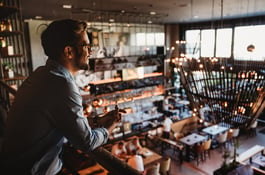Ghost kitchens weren’t born out of the pandemic. But their rise to popularity boomed across the past two-plus years, as countless existing restaurants sought ways to create additional revenue streams. Now, as in-person dining numbers tick back up, some brands are working in reverse, using ghost kitchens as a stepping stone to becoming a brick-and-mortar.
“I couldn’t get financing to open a brick-and-mortar, so I went the ghost kitchen route — I was able to build the popularity and finances I needed within the first six months,” says Robert Maleski, owner of Milly’s, a pizza operation that Maleski now runs out of a 800-square-foot restaurant in Chicago.
As ghost kitchens become more widespread, it brings into question, could they become a primary channel for entrepreneurs to test out new ideas, and even supersede alternatives like food trucks? Maleski says he didn’t initially consider a food truck because of the licensing and permitting processes, steps he could bypass with a ghost kitchen. Yet, while the concept sounds like a promising solution, there are notable disadvantages, too. We take a look at some of the pros and cons of starting a new venture as a virtual restaurant.
Lower barriers to entry
The ghost kitchen market is on track to becoming a trillion-dollar industry by 2030, according to data from Euromonitor. And the model brings obvious appeal, selling the promise of lowering many of the barriers to starting a restaurant, like labor and overhead. Maleski estimates that he spent $3,000 to get Milly’s up and running. But as he sees it, the greatest benefit is being able to test your product in the market before opening an entire restaurant.
“Once you open a restaurant, you have to get a license, get all these inspections completed, and source all the equipment yourself,” says Maleski. “You’re responsible for everything whereas with a ghost kitchen, you’re paying them an hourly fee, and they maintain everything and do most of the cleaning, too.”
Testing the market
Ghost kitchens provide time to tweak menu items and build a fan base, without a huge upfront commitment. Depending on the level of success, it’s not rare for the experience to shape and change future goals all together.
Wisconsin’s The Cluckery, for example, had zero inventions to ever open an in-person restaurant. Yet, after a year and a half of selling fried chicken out of a ghost kitchen, the brand now has a brick and mortar, too, and a new goal of opening more on a national scale.
“The idea really came about because of the overwhelming initial success and customer feedback asking for us to expand,” says Charlie Keller, The Cluckery’s marketing manager.
From the beginning, The Cluckery saw an empty space in their surrounding market for fried chicken. But the ghost kitchen experience proved demand for their product.
“It’s kind of like a lemonade stand. You have your idea, and you get to work through the growing pains and learn from there without rushing into something and trying to franchise immediately,” says Keller.
Not for everyone
Yet, while many have found success in ghost kitchens, most operators agree they have limitations. And some wish they’d taken another route entirely.
“If I had to do it over again, we’d absolutely have skipped the virtual kitchen concept,” says Steven Jarczyk, co-owner of Sfera Sicilian Street Food. “We didn’t leave the ghost kitchen with a lot of value in terms of money made and brand growth, and something like a food truck, that we could’ve continued to run, probably would’ve been a better stepping stone.”
Jarczyk and his business partner, Daniela Vitale, originally started their business at farmers markets, selling arancini to their local community. With COVID, they pivoted. But they quickly found themselves missing the regular customer interaction of the markets, something they quickly came to believe is essential to their brand.
“Being in a 200-square-foot space in the virtual market doesn’t allow you to connect with your customers at all,” says Jarczyk. “And third-party apps provide very little space to be seen. You’re in this massive, competitive market, and as a growing brand, you’re hidden on page 15.”
Unlike with neighborhood brick and mortars, third-party apps aren’t an easy space to draw in organic traffic. At the same time, the relationship between virtual restaurants and third-party apps is usually one of dependency.
“We had to spend quite a bit of money on PR and marketing,” says Jarczyk. “Otherwise you have to give UberEats and DoorDash more of your money to be more visible, when these apps are already taking a massive amount of your top line.”
Limited growth capability
Jarczyk points out that in ghost kitchens, you’re also generally working out of very tight spaces. And in terms of the cost per square footage, it’s not always that much cheaper.
“When you calculate the rent and storage fees, the reality is that these small businesses are paying huge expenses to be in these small spaces,” saysa Jarczyk.
It’s not unordinary in the ghost kitchen world to pay a premium for square footage in exchange for convenience and low commitment. And it’s especially common now, given current market rental rates have significantly dropped in many areas as a result of pandemic vacancies.
Maleski says for his Chicago pizza spot, he pays just a few hundred dollars more per month than he paid the ghost kitchen. And in return, he gets an entire space of his own.
“With the ghost kitchen, you’re sharing a space, you’re sharing equipment, you’re even sharing tables, so it was always like I was in frantic mode, and as my demand increased, it became more challenging,” says Maleski. “ I reached a point where I just wanted to have my own space, where I could go at my own pace.”
With a larger space, Maleski is also able to make more pizzas, and in turn, continue to grow his customer base, all of which helps to pay for the cost of increased rent. But despite ultimately being happier in a brick and mortar, he still views ghost kitchens as a great place to start.
“If you have a passion for a particular food product, I would say go for it,” says Maleski. “You get a chance to test your product in the market, and you can market yourself through Facebook and Instagram.”
Meanwhile, Jarczyk and Vitale are looking forward to leaving Sfera’s ghost kitchen days behind, now gearing up to launch their first full-service restaurant this month.
“I think it’s a really great concept for already well-recognized brands, like Famous Dave’s or Panera,” says Jarczyk. “But for us, we were susceptible to the sales pitch of it being less capital needed to open, and it ultimately prevented us from growing our customer base.”
[Photo courtesy Garrett Sweet]




